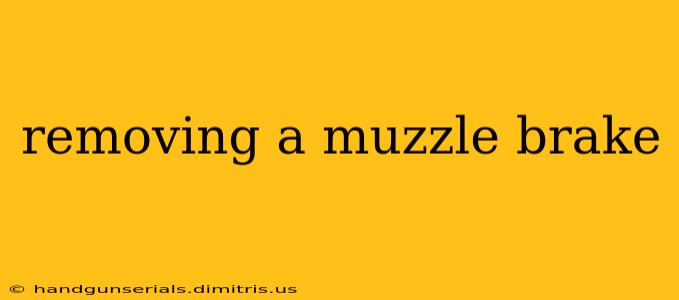Removing a muzzle brake might seem straightforward, but improper techniques can lead to damage to your firearm or injury. This comprehensive guide details the safe and effective removal of a muzzle brake, covering various types and offering troubleshooting tips. Whether you're upgrading your firearm, cleaning it thoroughly, or simply need to remove the brake for storage, this guide will walk you through the process step-by-step.
Understanding Muzzle Brakes and Their Attachment
Muzzle brakes are attached to the end of a firearm's barrel to reduce recoil and muzzle rise. They come in various designs, but generally utilize one of two primary attachment methods:
1. Threaded Connections:
The most common method involves screwing the muzzle brake onto the barrel's threaded end. The threads are typically fairly coarse and easily identifiable. Always ensure you understand the direction of the threads before attempting removal; some are left-hand threads, requiring counter-clockwise rotation to loosen.
2. Clamp-on or Compression Systems:
Less common than threaded systems, these utilize a clamping mechanism to secure the brake to the barrel. These systems often require specialized tools for removal. Consult your firearm's manual for specific instructions on removing this type of muzzle brake.
Tools and Materials Required
Before you begin, gather the necessary tools to ensure a safe and efficient removal:
- Appropriate Wrench: This is crucial. The size and type of wrench will depend on the muzzle brake's design and thread pattern. You might need a standard wrench, an adjustable wrench, or a specialized muzzle brake wrench. Using the wrong wrench can easily damage your brake or barrel.
- Gun Vice (Recommended): A gun vice securely holds your firearm, allowing for controlled and safe removal of the muzzle brake. This prevents accidental discharge and protects your firearm from damage.
- Penetrating Oil (Optional): If the brake is difficult to remove due to rust or corrosion, applying a penetrating oil like PB Blaster can help loosen it. Allow sufficient time for the oil to penetrate before attempting removal.
- Clean Rags: Essential for cleaning up any oil or debris.
- Eye and Hearing Protection: Always wear safety glasses and hearing protection when working with firearms.
Step-by-Step Guide to Removing a Threaded Muzzle Brake
- Safety First: Unleash the firearm and ensure it's unloaded. Double-check the chamber and magazine to confirm there are no rounds present.
- Secure Your Firearm: Place your firearm in a gun vice, ensuring it's firmly clamped and the barrel is securely supported.
- Apply Penetrating Oil (If Necessary): Liberally apply penetrating oil to the threads where the muzzle brake connects to the barrel. Allow it to sit for at least 15-20 minutes, or longer if necessary.
- Select the Correct Wrench: Choose the wrench that properly fits the muzzle brake's flats or the wrench specifically designed for your brake.
- Apply Steady Pressure: While holding the firearm securely in the gun vice, use the wrench to gently begin turning the muzzle brake counter-clockwise (unless it is a left-hand thread). Avoid sudden forceful movements, as this can damage the threads.
- Persistence is Key: If the brake is stuck, apply more penetrating oil and allow more time to soak in. Continue applying gentle, consistent pressure to loosen the brake. If excessive force is needed, seek the assistance of a qualified gunsmith.
- Removal: Once the muzzle brake is loose, carefully unscrew it by hand.
- Cleaning: Clean the barrel threads and the muzzle brake threads thoroughly using a suitable cleaning brush.
Troubleshooting
- Stuck Muzzle Brake: If the brake is stubbornly stuck, apply heat carefully (using a heat gun set to a low temperature) to the brake to help expand the metal. Never apply heat directly to the barrel.
- Damaged Threads: If the threads are damaged during removal, you may need to seek professional help from a qualified gunsmith. Attempting to force the brake off could result in irreparable damage to your firearm.
- Left-Hand Threads: Always double-check your firearm's manual or the muzzle brake's markings to confirm the thread direction. Incorrectly turning a left-hand thread can damage it.
Conclusion
Removing a muzzle brake requires care, patience, and the right tools. Following these steps and prioritizing safety will ensure a smooth and successful removal. Remember, if you're unsure about any aspect of this process, always consult a qualified gunsmith. Your safety and the well-being of your firearm should always be your top priorities.

